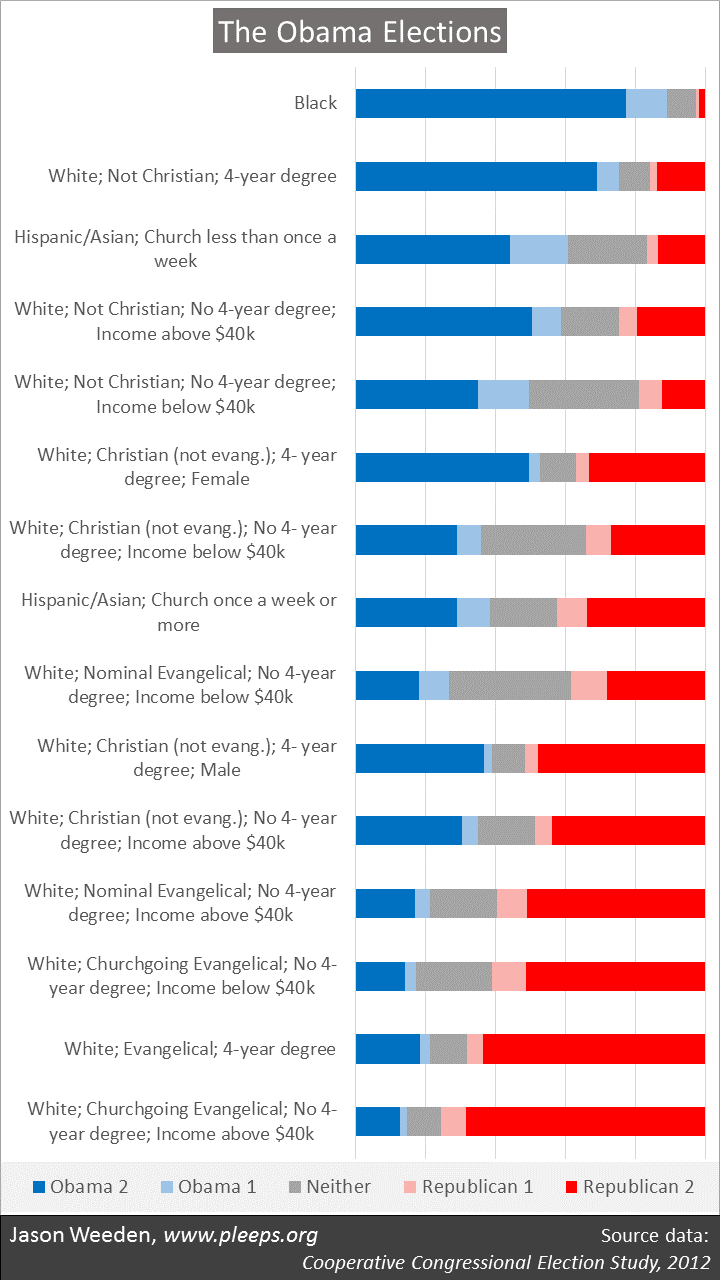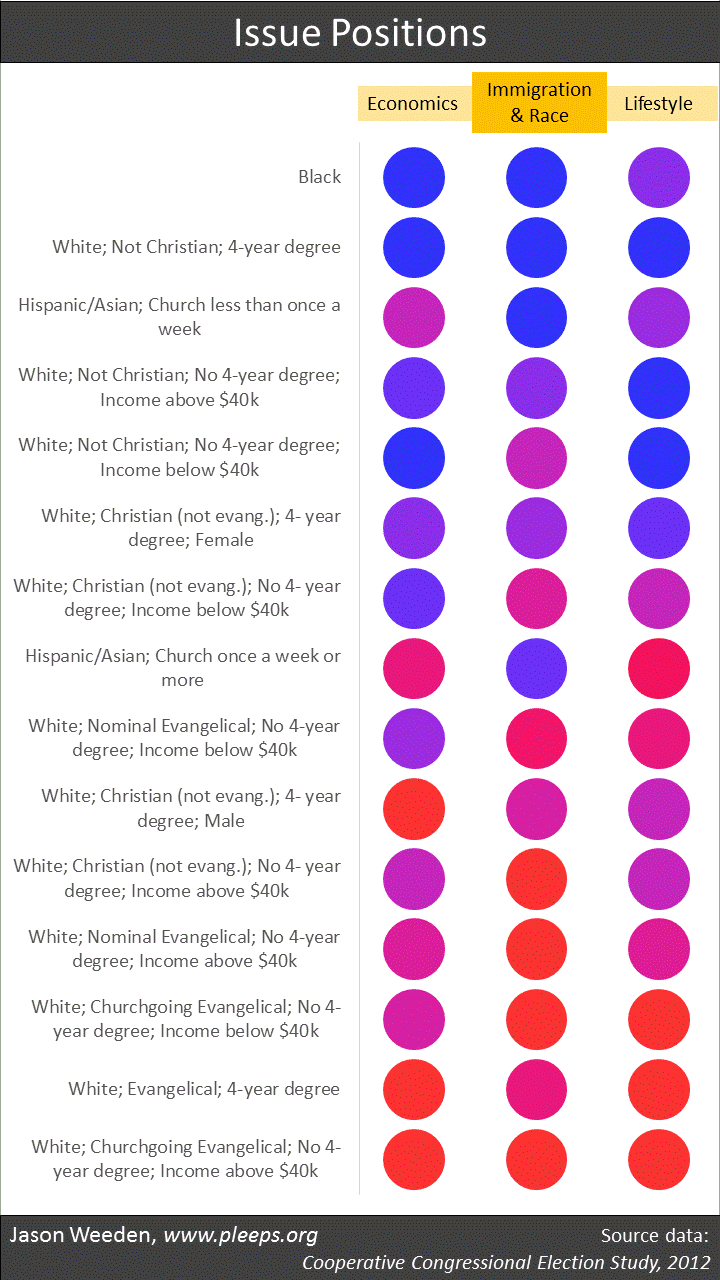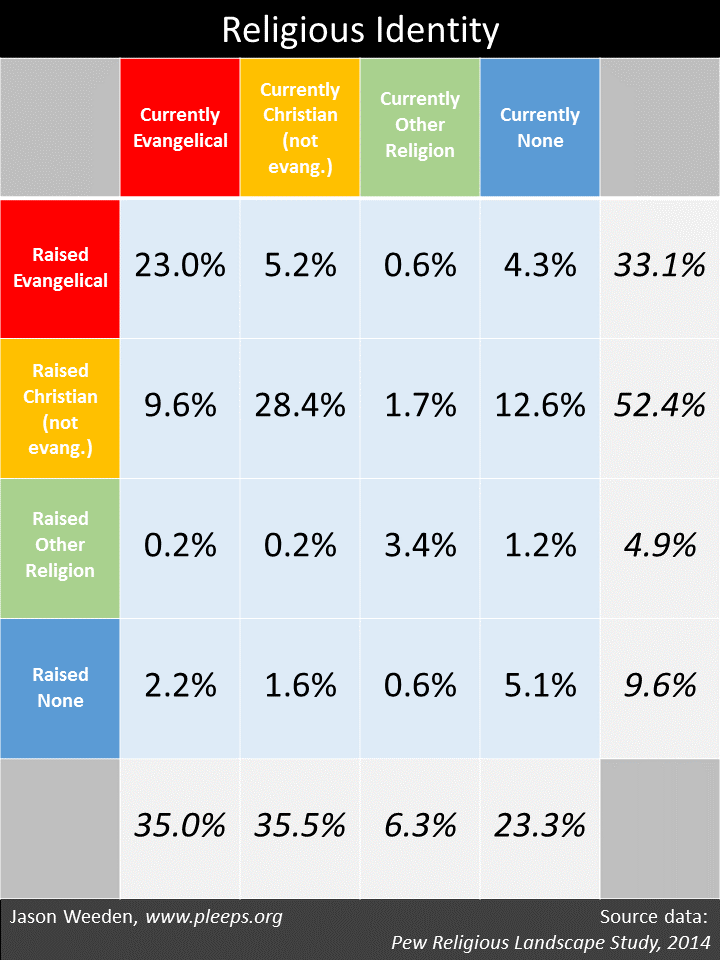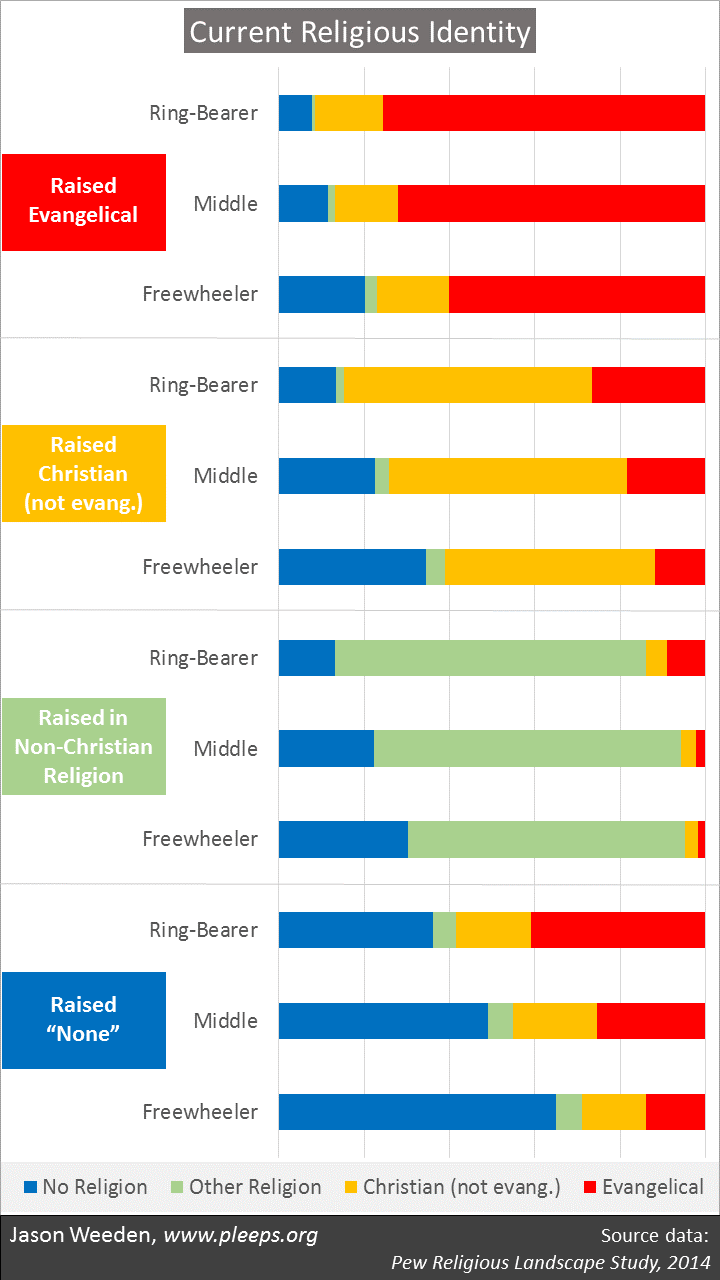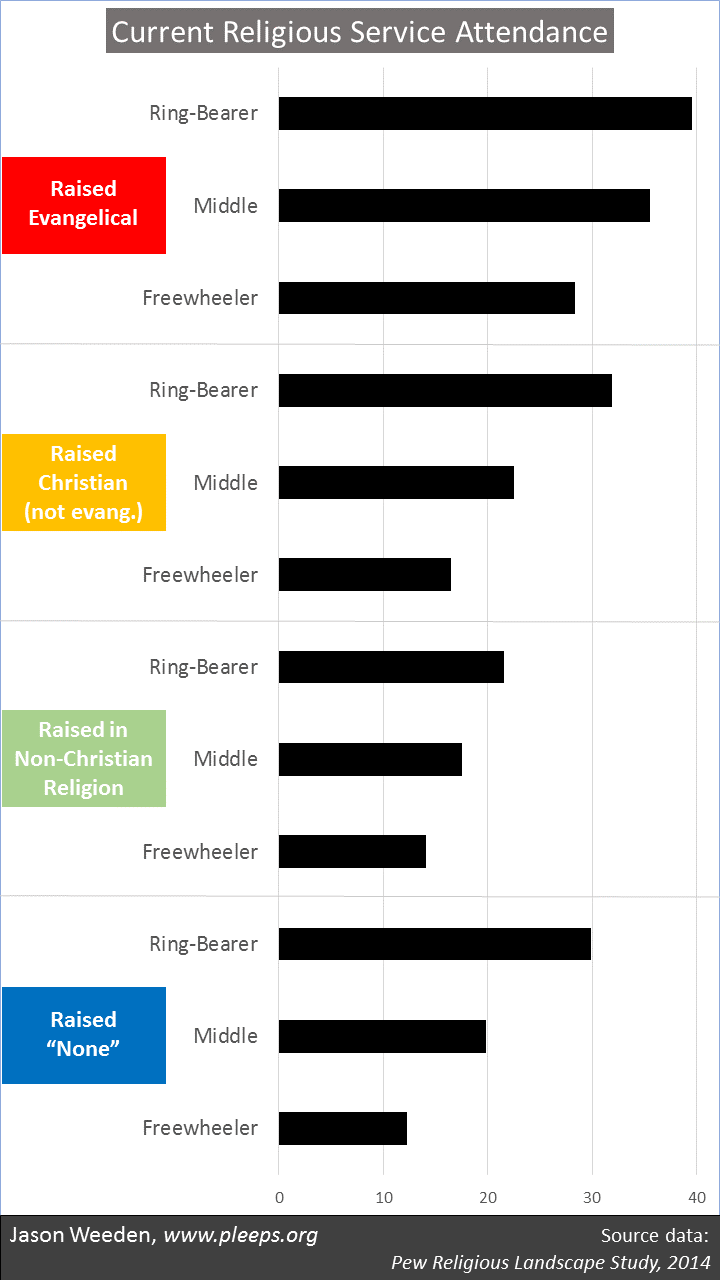This year I made blogging a semi-regular thing. I typically spend a good deal of time looking at data, but it hadn’t really occurred to me before to blog about it as I’m doing it. It’s been a lot of fun, and it’s interesting for me to see when other people find it interesting (and when they don’t).
I did a couple of somewhat-organized series of posts, but mostly the blog has just followed whatever I happened to be looking into at a given moment. It often has to do with what new dataset I’m unpacking. For example, many of the posts this year stem from my having decided to tackle Pew’s political datasets. I was able to do a bunch of posts pretty quickly once I had my big recoded/merged Pew file in shape.
Given that the blog jumps around quite a bit, I thought I’d end the year with a narrative index. Below are quick pointers to this year’s posts, roughly organized by subject matter.
Politics
Many of my posts were about how demographics relate to politics. Some of these posts were on general themes: Ideology (and ideological extremes), party affiliation (and also specifically on white partisanship), voting patterns in the Obama elections, and voter registration. I also had some general posts on the decline of white Christians, the rise of libertarian demographics, and the funky differences between Millennials and older folks.
Other posts were about demographic differences in views on specific kinds of issues: racial discrimination, immigration and anti-Muslim views (and white nationalism generally), income redistribution (and how different groups’ economic views have changed over time), and marijuana legalization. I also had a post that was more explanatory and less data-driven on discrimination and political correctness.
Some political posts were specific to the 2016 presidential election, including two posts involving pre-election polls, one on the 2016 exit polls, and one that tried to puzzle through what would have happened in the Clinton/Trump race under various epistocracy scenarios that give more voting power to knowledgeable voters.
I responded to a review of my book, mainly to try to clear up some points about the relationship between evolutionary psychology and behavioral genetics. (Back in 2015 I also had a very long back-and-forth with Bryan Caplan about the book. It goes Caplan, then me, then Caplan, then me, then Caplan, then me, then Caplan, then me, then Caplan, then me.) I also had a post this year about some problematic claims by Achen and Bartels in their book.
Religion
I did a four-part series on religiosity and lifestyles. First, I introduced the issue—namely, there are contrasting claims about whether increased church attendance is associated with fast or slow life-history patterns. Then I covered a problem with the religiosity-is-fast position—it’s based on group-level data. Then I covered a problem with the religiosity-is-slow position—it mistakenly claims that restricted sociosexuality is part of slow life-history. And, finally, I gave what I’m pretty sure is the right answer: Churchgoers are restricted individuals in fast groups.
I summarized my new article with Kenrick and Kurzban about our views on religiosity and reproductive strategy. I showed some basic religion-switching patterns from childhood to adulthood, including how these patterns relate to lifestyle differences. I also showed the longer-term generational trends, where religiosity has been declining for every generation since those born in the late 1930s.
I looked at the basic differences in religiosity between degreed and non-college folks, as well as the issue of when Christians tend to see themselves as “born again or evangelical.”
Fertility
I did a long series of posts on modern fertility from an evolutionary point of view. I introduced the puzzle and then I gave some empirical background on U.S. fertility over the past century (mainly to show that we’re not talking about a simple phenomenon). I then presented some new analyses of college women, where it turns out that the vast majority of them really want to have kids. That set up the central theme—namely, why lots of women who start off wanting two or more kids end up have none or only one these days. To give a (partial) answer, I introduced the idea of a three-way trade-off by imagining an advice-column response to a young woman who wants to have lots of rich, sexy offspring.
Then came the key post of this fertility series, one that includes some new analyses showing the 3D rich-sexy-lots trade-off in modern fertility. This suggests that one explanation for very-low modern fertility is that it’s in part a consequence of attempting to simultaneously maximize the wealth and attractiveness of one’s potential offspring. I then did a sidebar post on how evolution can produce strategic flexibility that goes beyond the usual concept of decision rules. And, finally, I offered concluding thoughts, mostly about how complicated it’ll be to really sort this stuff out.
Economics
I did a couple of posts on basic economic trends. In one, I looked at how personal incomes have changed over the past few decades as a function of gender, age, education, and hours worked. In another, I took a look at the recent alarm over idle young men living with their parents (turns out that the basic facts are less impressive than many have claimed).
Hits and misses
Three of my posts went viral (umm, you know, to the extent that extremely nerdy, data-driven posts can go viral): the one on how Millennials’ political opinions differ from those of older folks, the one that looks at how the Clinton/Trump race might have turned out in an epistocracy, and the one about how the big new thing involving idle men living with their parents isn’t very big or very new. Basically, those three posts have accounted for around two-thirds of the clicks my blog has ever received. I owe particular thanks here to Tyler Cowen for linking to those posts—thanks Tyler!
Beyond those, there were some basic political posts that did pretty well—on liberal/conservative demographics, on libertarian demographics, on the 2016 exit polls, and others. Also, some of the posts in the two multi-part series I mentioned above—on religiosity and life-history and on modern fertility and evolutionary psychology—got decent numbers of hits.
Of course, there were also a few posts that I thought were interesting, but weren’t widely read. For example: on the demographics of the Obama coalition (something that’s often misunderstood and/or misrepresented, which becomes important when thinking through possible future changes to the existing party coalitions), on how evolution can produce strategic flexibility in big-brained creatures like us, and on education differences in religiosity. (And, while I’m at it, I thought that some of my posts from past years were also pretty interesting, even though there weren’t many people reading the blog in those days: on how white southern and Catholic men changed their party affiliations in the latter half of the 20th century, on how migration between blue and red states actually ends up making red states redder and blue states bluer, on the role of genes in politics, etc.)
Looking forward
Currently I’m in a bit of a holding pattern, waiting for new data. Most particularly, I haven’t yet been able to analyze individual-level data on the 2016 election. Some key datasets should be made public in 2017—primarily from Pew, ANES, and CCES. Those releases will unleash new flurries of data-driven posts.
In 2017 I’ll also be helping out with another wave (they happen once every 5 years) of the Harvard/Radcliffe Class of ’77 longitudinal study, which I’ve been involved with since 2001 (Kurzban and I talked about it some in chapter 7 of our book). I’ll probably wait until after my presentation at their reunion in the Fall, but then I’m sure I’ll do a number of posts. The study has lots of intriguing themes.
Here’s hoping 2017 is an interesting year. (Though I wouldn’t mind if it’s a bit less interesting than 2016.)

